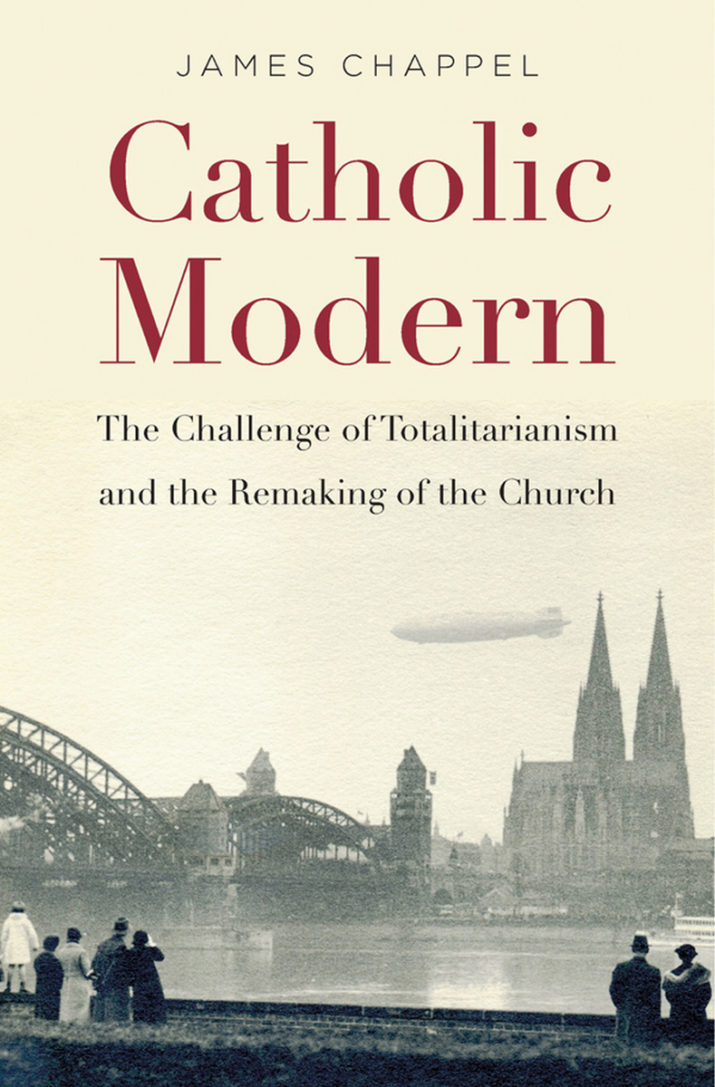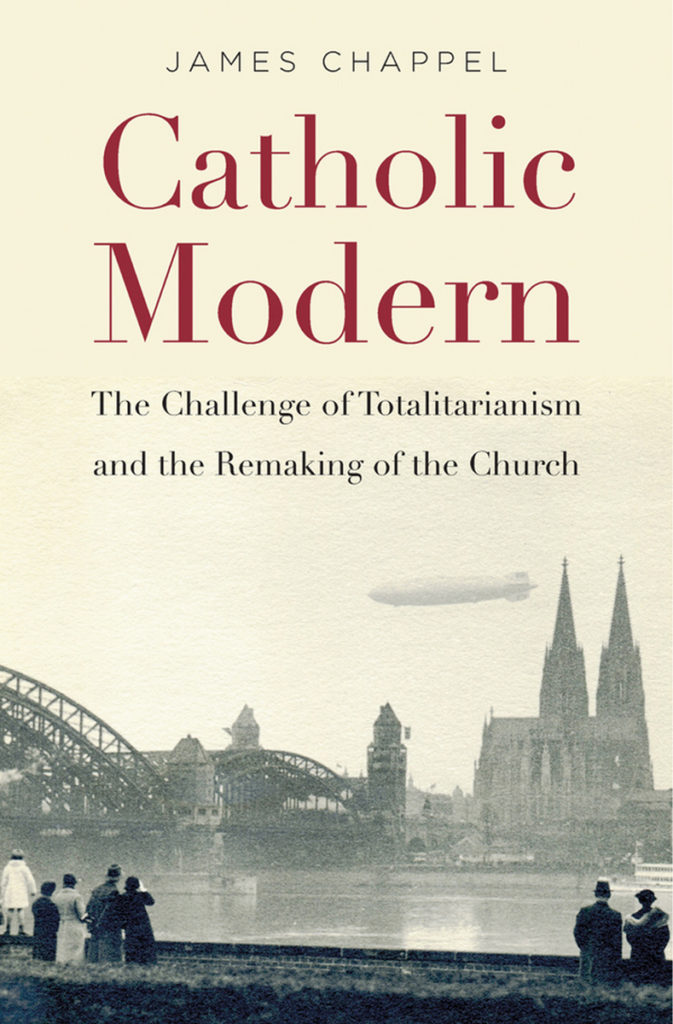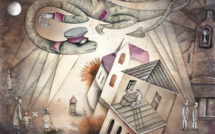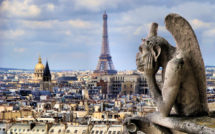
Catholic Modern: The Challenge of Totalitarianism and the Remaking of the Church by James Chappel
This is part of a roundtable on Notre-Dame de Paris.

The success of Christian Democratic parties in stabilizing the political orders, which emerged out of the devastation of the Second World War in countries such as Austria, Germany, Italy, and to a smaller extent, in France and other countries in Western Europe, remains one of the most important stories in the history of Europe in the twentieth century. The resiliency of Catholicism as a political force remains a strong argument against the secularization thesis that, until recently, dominated historical understanding of modern European societies and political orders. It is also easy to forget that the emergence of political Catholicism as a force for democracy and human rights in the post-1945 era was never a foregone conclusion. Indeed, at the beginning of the twentieth century, the leadership of the Catholic Church, as well as most prominent Catholic theologians and intellectuals, rejected religious pluralism, the secular state, and viewed most social and political developments that had emerged since the French Revolution with hostility, longing for the restoration of the harmonious order between Church and State in Medieval Europe.
How this transformation happened from the early 1920s to the late 1950s is the story of Duke University historian James Chappel’s book, Catholic Modern: The Challenge of Totalitarianism and the Remaking of the Church. Chappel chooses to focus nearly all of his attention on three countries, France, Austria, and Germany. While different Popes, Bishops, and Christian Democratic politicians are mentioned at different times, the author is primarily interested in Catholic political and social philosophers, some of which, such as Jacques Maritain and Diedrich von Hildebrand, are very well known, and others, such as Friederich Heer and Mina Wolfring, which are slightly more obscure. Chappel argues that the philosophical evolution that occurred in these three countries during the time period covered in work reveals a profound change in the Catholic Church, not just in Western Europe, but throughout the entire world, as one fully engaged in, and broadly accepting of, most elements of political, economic, and social modernism.
Chappel begins his analysis by discussing the intellectual milieu in Catholic intellectual circles in the 1920s as both victors in the Great War, such as France, and those on the losing side, such as Germany and Austria, dealt with cataclysmic impact of the Great War, which, in the case of the former Central powers, had swept away the imperial orders of the Hohenzollerns and the Habsburgs. For philosophers such as Georg Moenius and Charles Maurras, the Great War demonstrated the disastrous endgame of the “modern” trends, which had begun with the French Revolution, and there was no reason that another, even greater tragedy could not happen again. The solution, for these Catholic medievalists, was to restore the anticapitalist, preindustrial order of pre-1789 Europe, when Church and State were properly linked together—although most lacked a plan of action as to how this was to occur. By the 1930s, following the rise of Hitler in Germany, the collapse of democracy in much of Europe, and the ever-present specter of Stalin’s USSR in the East, two new dominant trends emerged in Catholic thought. Chappel labels these “paternal modernists” and the “fraternal modernists.” Both groups, unlike the medievalists, broadly accepted the modern, secular nation-state. Although they believed the Church still had a valuable role to play in it, neither were fully comfortable with modern capitalism, but were supportive of a substantial welfare state, and most of them tried to avoid political extremes. There were substantial differences between the two—the core of which was the fact paternal modernists were motivated primarily by anticommunism, while the fraternal modernists were guided by a strong antifascist ethos. The paternal modernists were quite accepting of a strong role for the state in protecting the traditional family, as well as promoting social and cultural conservatism. An equal priority for most of them was a desire to protect, in the words of the Germans and Austrians, the Abendland (literally, “the evening land,” or as Chappel correctly puts it, “the West”), especially from the dangers of Bolshevism and, to a lesser extent, laissez-faire capitalism. The fraternal modernists, while generally accepting of the commandments of the Church, believed that opposition to Fascism was the defining moral question of the age, and thus were open to alliances with socialists and other antifascists. Many were open to dialogue with Marxism, if not accepting of all its central tenets, and strongly rejected the linkage of Communism with Judaism, a belief very common in the anti-Semitic milieu of most of the paternal modernists of the 1930s.
The Second World War marked the end of Fascism as a viable political model in Europe—a political system that many of the paternal modernists saw as an ally in protecting the Abendland, even if they were usually careful not to link themselves too closely to it most of the time. The Holocaust forced a gradual but profound change in how the Church approached its long legacy of anti-Semitism, while the considerable role of Communists in the resistance to the Vichy state in France and Hitler’s rule in Germany and Austria, at times alongside Catholic fraternal modernists, the so-called “Dachau effect,” gave hope that in the immediate postwar era the best of Catholic and socialist teachings could create a socially just and politically stable order in Europe. This was the great hope of the leading fraternal modernist, legendary French Catholic intellectual Jacques Maritain, the hero of Chappel’s account, who did his utmost in the heady days of the mid-1940s to make it a reality.
The Cold War, which had emerged in force by the late 1940s changed all of this, leading to revival of paternal modernism, including the defense of the Abendland (this time in league with the American government) as Christian Democrats took power in both the Federal Republic of Germany and Austrian Second Republic and dominated politics until the mid-1960s, while in France the MRP (Mouvement Républicain Populaire) played a significant role in the political life of the Fourth Republic. While the concerns of protecting the traditional family structure remained a strong priority, Christian Democrats of the 1950s were far more open to cooperation with Protestants, Socialists, and Jews on various political issues, and the authoritarian elements were finally excised, as was, eventually, the central idea of the defense of the West. By the time of the social and cultural transformations beginning in the mid-1960s, the successors of the fraternal modernists returned to once again attempt to redefine the Church’s role in the modern world, one more, in their words, socially and economically just, a debate that, as Chappel rightly notes, continues up to this day.
There are many things to commend in Chappel’s work, which is written strictly for specialists in the field of European Catholic intellectual history, the general reader would easily get lost in the terminology. The depth of his knowledge of the Catholic intellectual milieu in France, Austria, and Germany during the five decades discussed in the book is very impressive, and he does an excellent job of explaining their intellectual beliefs and how they differed from each other. He also does a commendable job of explaining what the paternal and fraternal modernists were, and how the different intellectuals and activists he discusses fit into one category or the other, including times when drifted between the two categories. His argument that the 1930s marked a period when Catholic thinkers in all three countries, despite their considerably ideological differences, all accepted the need to engage in the modern world, as opposed to quixotically hoping to restore a medieval order, and that was dominant view going forward, is clearly supported by the evidence. Finally, Chappel does a commendable job demonstrating that the “long 1950s” from 1947 to 1965, were not a period of staid stagnation bur rather one of enormous poltical and cultural transformation, one whose legacy ultimately outlasted the Cold War itself.
There are, however, some considerable weaknesses. Chappel tends to describe opinion as fact, such as claiming the votes of the Center Party in Germany for the Enabling Acts “brought Hitler into power,” implying that was the central factor, or that the Cold War environment of the late 1940s and early 1950s had a “suffocating impact” on Catholic intellectual life. Chappel is far too hard on the Waldemar Gurian in particular, treating his support of American containment policies in the early 1950s as a profound moral failing, without fully acknowledging how the brutal impact of Stalinism on the Churches on the Eastern side of the Iron Curtain could lead Gurian on a path to confront what he rightly viewed as a great force of evil in the world. But these are minor problems compared to largest weakness of the work, which is that Chappel’s selection of examples from Catholic political and social theorists in France, Austria, and Germany cannot support his broader conclusions about the Catholic Church in Europe, to say nothing of the rest of the world. By his own admission, the selection of the intellectual environment of three other largely Catholic countries, such as Spain, Portugal, and Italy, could lead to a very different book, and one whose conclusions could not be realistically used to generalize about the Catholic Church as a whole. The inclusion of France as opposed to Italy is a strange choice, given the fact the Italian Christian Democrats were far more influential than their counterparts in France. Even more inexplicable is a book whose title concerns the Church’s confrontation with totalitarianism does not discuss, besides a few passing mentions of figures such as Jozsef Mindszenty and Karol Wojtyla, the experience of the Catholic Church in Poland, Hungary, and Czechoslovakia, among the other lands of Eastern Europe, which experienced Fascist and then Communist rule, not just the latter’s implied threat, and functioned under a vastly different environment after the Second World War. A true examination of how the Catholic Church in Europe became “modern” in the early to mid-twentieth century, and how the process effects the Church today, necessitates a thorough examination on both sides of the Iron Curtain, not just those to its West.
Reviewed by Sean Brennan, University of Scranton
Catholic Modern: The Challenge of Totalitarianism and the Remaking of the Church
By James Chappel
Harvard University Press
Hardcover/ 342 pages/ 2018
To read more book reviews click here
Published on October 2, 2019.




